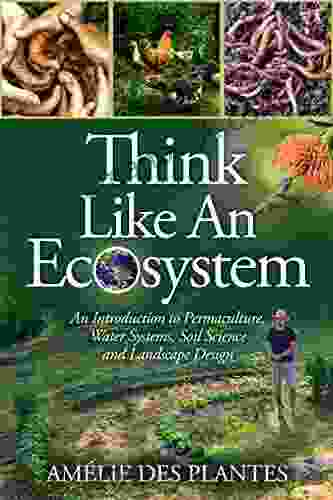An Introduction to Permaculture Water Systems, Soil Science, and Landscape Design

Permaculture is a design system that integrates ecology, agriculture, and community development. It emphasizes sustainability, self-sufficiency, and working with nature to create a harmonious and productive environment. Water, soil, and landscape are three key elements of permaculture design. Understanding the principles of water systems, soil science, and landscape design is essential for creating a successful permaculture system.
Water Systems
Water is essential for life, and it is a precious resource that we must manage wisely. Permaculture water systems aim to collect, store, and use water in a sustainable way. There are many different types of water systems that can be used in permaculture, including:
4.7 out of 5
| Language | : | English |
| File size | : | 6367 KB |
| Text-to-Speech | : | Enabled |
| Screen Reader | : | Supported |
| Enhanced typesetting | : | Enabled |
| Word Wise | : | Enabled |
| Print length | : | 196 pages |
| Lending | : | Enabled |
* Rainwater harvesting: This involves collecting rainwater from rooftops and other surfaces and storing it in tanks or cisterns. Rainwater is a pure and free source of water that can be used for drinking, watering plants, and other purposes. * Greywater systems: Greywater is wastewater from sinks, showers, and baths. It can be treated and reused for watering plants or flushing toilets. * Blackwater systems: Blackwater is wastewater from toilets. It is high in nutrients and can be treated and reused to fertilize plants. * Swales: Swales are shallow ditches that are used to collect and divert rainwater. They can also be used to slow down erosion and promote infiltration. * Berms: Berms are mounds of earth that are used to hold back water and create microclimates. They can be used to create ponds, swales, and other water features.
The type of water system that is best for a particular site will depend on the climate, the soil type, and the available resources. It is important to design a water system that is integrated with the other elements of the permaculture system, such as the soil and plants.
Soil Science
Soil is the foundation of any permaculture system. It provides plants with nutrients, water, and support. The health of the soil is essential for the health of the plants and animals that live in the system.
There are many different types of soil, each with its own unique properties. The type of soil that is best for a particular plant will depend on the plant's needs. For example, some plants prefer well-drained soils, while others prefer moist soils.
It is important to understand the properties of the soil on your site before you begin planting. You can do this by conducting a soil test. A soil test will tell you the pH of the soil, the nutrient content, and the texture. This information can help you choose the right plants for your site and develop a management plan for your soil.
There are many different ways to improve the health of the soil. Some of the best methods include:
* Adding organic matter: Organic matter, such as compost and manure, helps to improve the soil's structure, fertility, and water-holding capacity. * Cover cropping: Cover crops are plants that are grown to cover the soil and protect it from erosion. They also help to improve the soil's fertility. * Mulching: Mulch is a layer of organic matter that is spread on the soil surface. It helps to retain moisture, suppress weeds, and regulate soil temperature. * No-till farming: No-till farming is a method of farming that does not disturb the soil. It helps to improve the soil's structure and reduce erosion.
Landscape Design
Landscape design is the art of arranging the elements of a landscape to create a beautiful and functional space. In permaculture, landscape design is used to create a system that meets the needs of the people and animals that live in it.
There are many different principles of landscape design that can be used in permaculture. Some of the most important principles include:
* Diversity: Diversity is key to a healthy and resilient permaculture system. It helps to reduce the risk of pests and diseases, and it provides a variety of habitats for different plants and animals. * Integration: The elements of a permaculture system should be integrated with each other to create a harmonious and productive environment. For example, the water system should be integrated with the soil and the plants. * Succession: Succession is the process of natural change in a landscape. In permaculture, we can use succession to our advantage by planting a variety of plants that will mature at different times. This will help to create a system that is always productive and beautiful.
Landscape design is a complex and challenging subject, but it is also a rewarding one. By understanding the principles of landscape design, you can create a beautiful and functional permaculture system that will provide for your needs for years to come.
Water systems, soil science, and landscape design are three key elements of permaculture design. By understanding the principles of these elements, you can create a sustainable and productive system that meets the needs of the people and animals that live in it.
4.7 out of 5
| Language | : | English |
| File size | : | 6367 KB |
| Text-to-Speech | : | Enabled |
| Screen Reader | : | Supported |
| Enhanced typesetting | : | Enabled |
| Word Wise | : | Enabled |
| Print length | : | 196 pages |
| Lending | : | Enabled |
Do you want to contribute by writing guest posts on this blog?
Please contact us and send us a resume of previous articles that you have written.
 Top Book
Top Book Novel
Novel Fiction
Fiction Nonfiction
Nonfiction Literature
Literature Paperback
Paperback Hardcover
Hardcover E-book
E-book Audiobook
Audiobook Bestseller
Bestseller Classic
Classic Mystery
Mystery Thriller
Thriller Romance
Romance Fantasy
Fantasy Science Fiction
Science Fiction Biography
Biography Memoir
Memoir Autobiography
Autobiography Poetry
Poetry Drama
Drama Historical Fiction
Historical Fiction Self-help
Self-help Young Adult
Young Adult Childrens Books
Childrens Books Graphic Novel
Graphic Novel Anthology
Anthology Series
Series Encyclopedia
Encyclopedia Reference
Reference Guidebook
Guidebook Textbook
Textbook Workbook
Workbook Journal
Journal Diary
Diary Manuscript
Manuscript Folio
Folio Pulp Fiction
Pulp Fiction Short Stories
Short Stories Fairy Tales
Fairy Tales Fables
Fables Mythology
Mythology Philosophy
Philosophy Religion
Religion Spirituality
Spirituality Essays
Essays Critique
Critique Commentary
Commentary Glossary
Glossary Bibliography
Bibliography Index
Index Table of Contents
Table of Contents Preface
Preface Introduction
Introduction Foreword
Foreword Afterword
Afterword Appendices
Appendices Annotations
Annotations Footnotes
Footnotes Epilogue
Epilogue Prologue
Prologue Lyn Hejinian
Lyn Hejinian Donald Charles
Donald Charles Luchrisa Valentine
Luchrisa Valentine Jeanne St James
Jeanne St James Barbi Cox
Barbi Cox Mark Dunn
Mark Dunn Bill Browder
Bill Browder Dr Edward Joseph
Dr Edward Joseph The Brothers Rodemeyer
The Brothers Rodemeyer Kindle Comixology
Kindle Comixology Norm Foster
Norm Foster Flora Madison
Flora Madison Debra Kayn
Debra Kayn Douglas A Blackmon
Douglas A Blackmon Glenn Trust
Glenn Trust Kimberly Diede
Kimberly Diede Roberta Kagan
Roberta Kagan Foxy Feather
Foxy Feather Okongor Ndifon
Okongor Ndifon Rachael Thomas M S Ed
Rachael Thomas M S Ed
Light bulbAdvertise smarter! Our strategic ad space ensures maximum exposure. Reserve your spot today!
 Spencer PowellFollow ·4.3k
Spencer PowellFollow ·4.3k John GreenFollow ·17.4k
John GreenFollow ·17.4k Levi PowellFollow ·17k
Levi PowellFollow ·17k Cason CoxFollow ·8.1k
Cason CoxFollow ·8.1k Jesus MitchellFollow ·4.2k
Jesus MitchellFollow ·4.2k Sammy PowellFollow ·7.4k
Sammy PowellFollow ·7.4k Chris ColemanFollow ·11.6k
Chris ColemanFollow ·11.6k Jackson BlairFollow ·7k
Jackson BlairFollow ·7k

 Ernest Powell
Ernest PowellBenefits of Corporal Punishment: A Review of the...
Corporal punishment is a form of physical...

 Bobby Howard
Bobby HowardThe Development and Significance of African American...
African American...

 Guy Powell
Guy PowellDown Girl: The Logic of Misogyny - A Comprehensive...
In her groundbreaking work,...

 Forrest Blair
Forrest BlairThe Bikini Changing Room: A Micro Mini Romance
In the heart of...
4.7 out of 5
| Language | : | English |
| File size | : | 6367 KB |
| Text-to-Speech | : | Enabled |
| Screen Reader | : | Supported |
| Enhanced typesetting | : | Enabled |
| Word Wise | : | Enabled |
| Print length | : | 196 pages |
| Lending | : | Enabled |
















